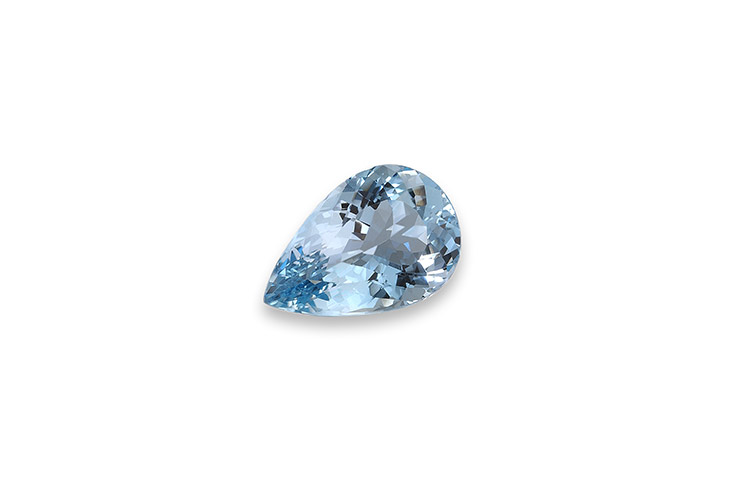Guide to Aquamarine

History, Lore and Appreciation
Aquamarine reminds us of the sea; its watery greenish blue colors have elicited such comparisons for centuries. In 1609, Flemish mineralogist and scholar Anselmus Boetius de Boodt first drew this association and his description became universal. The Latin root names, aqua and marina, literally translate to “water of the sea.” Aquamarine is a gem of subtlety with its light and clear pastel hue, tones they are best associated with. However, some deposits have yielded deeply saturated blue colors, and they are considered rare. It is often worn for evening events when the gems can gleam enticingly, even in low lighting conditions. Despite the understanding that subtlety is part of an aquamarine’s character, depth of color remains an important characteristic as well.
Aquamarine differs greatly from emerald, despite being varieties of the same mineral. Unlike emerald, for instance, aquamarine frequently forms as large crystals – sometimes weighing hundreds of carats. Additionally, it frequently possesses a vitreous clarity not found in emerald. For this reason, aquamarine may be fashioned as exceptional clean gems and carvings. That said, some aquamarine is sufficiently included to impart a slightly milky appearance.
In other rare cases, the inclusions are miniscule, hollow growth tubes that form parallel to one another, causing chatoyancy (cat’s eye effect) in the gem.
Birthstones and Anniversaries
Aquamarine is the birthstone for March. It is also considered to be a 19th wedding anniversary gemstone.
Description and Properties
Aquamarine is an important member of the beryl family of gems, and forms in the hexagonal crystal system. It has the following composition: Be3Al2Si6O18.
Color: Generally transparent and greenish blue, to blue green and generally light in tone. Deeper blues are less common; some highly included aquamarine has a milky, translucent quality.
Refractive Index: 1.577 to 1.583 (±0.017) Birefringence: 0.005 to 0.009
Specific Gravity: 2.72
Cause of color: iron
Mohs Hardness: 7.5 to 8.0
Internal identifying characteristics: Inclusions in fine aquamarine are sometimes hard to find. However, fluid inclusions including two and three-phase inclusions (containing a liquid, a solid and a gas), sometimes referred to as “fingerprint” inclusions, are sometimes seen. Parallel hollow growth tubes may be present and if in sufficient quantity may cause a chatoyant effect in cat’s eye aquamarine.
Treatments
More often than not, slightly greenish blue aquamarine is heat-treated, causing it to mitigate a secondary yellowish color component (that causes some aquamarines to look very slightly greenish blue). The treatment results in a purer blue color. Most aquamarine in today’s market is considered to be heat-treated, although it is generally impossible to determine that fact gemologically.
Collector Quality
Aquamarine with a saturated blue color is especially desirable, though a few beryl collectors prefer a slight greenish tinge since such gems follow the “classic” description of aquamarine. Unusually cut gems are also popular, especially in gems that have been fashioned by an important lapidary artist. Aquamarine and other beryls often lend themselves to sculptures because of their size. Locality plays a role in collecting as well. Aquamarine from desirable localities, such as Santa Maria in Itabira or Marambaia, in the state of Minas Gerais, Brazil, are collectible due to its legendary depth-of-color. Ukrainian green beryl and aquamarine also became sought after as mineral specimens thanks to their startling sizes, peculiar growth etching and deep colors.
Localities
Aquamarine forms in pegmatites on almost every continent. Brazil is perhaps one of the best-known localities for aquamarine – as well as various other beryls.
The gem-rich state of Minas Gerais is Brazil’s strongest producer, though important finds first occurred in Rio de Janeiro, and later as exploration into the interior continued, in Ceará, Espírito Santo and Bahia.
Other strong producers include Pakistan’s Skardu district and Ukraine. Other Asian localities include Tajikistan, Afghanistan, India and China. China, particularly, is emerging as an important producer. Aquamarine is also mined at several localities in the United States, but perhaps the most significant is Mt. Antero in Colorado. African aquamarine has been found at deposits in the Zambézia province of Mozambique (where deep-colored “Santa Maria Africana” aquamarines are found), Kenya, Malawi, Tanzania, Namibia, Nigeria and Madagascar.
Cutting, Care and Cleaning
Aquamarine’s hardness of 71/2 to 8, combined with being relatively inclusion- free, gives it good toughness as a gemstone if it is worn under normal use. Large aquamarines should be worn with care, especially in settings such as rings that can be easily knocked. It is best when prongs are placed in corners of square-shaped gems, because they can protect the gems from chipping at sharp angles and facet junctions. Aquamarine may be cleaned in an ultrasonic cleaner if it does not have inclusions that might expand or endanger the integrity of the gem. Sudsy water followed by wiping with a damp cloth is a good and safe way to clean an aquamarine.
Source: CIBJO Retailer Reference Guide, cibjo.org. Image: American Gem Trade Association